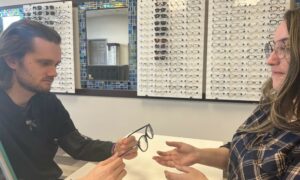By Ally Stoeger, OD
I recently had the experience of going to an urgent care facility to remove part of a tick I had been unable to remove on my own. I showed the doctor where the piece of tick attached to my leg, and he couldn’t see it. He told me I must have great vision. I told him he needed an eye exam. So I showed him again, and he still couldn’t see it until he pulled out a magnifying scope.
His response to my telling him he needed an eye exam was that his vision is good becausehe “sees with one eye for distance and the other for close.” Great.I hope his night driving eye is better than his near vision eye.
I don’t know who that doctor’s eye doctor is, but I wonder if he or she took the time to explain the difference between the legal driving minimum of “seeing” versus seeing as well as you can.
The problem: Some eye doctors settle for simply providing their patients with”20/Happy.” Here are some ways that such a prescription might affect performance:
–Attorneys or CPAs who work on hourly fees. If 15 minutes can equal $75, I sure hope that their last eye doctor was able to explain the difference between seeing vs. seeing as efficiently as you can.
–People who have to drive after dark–oh, wait a minute–that’s almost everyone in the winter. Do you want the people who are driving the same dark icy roads as your loved ones having 20/100 in one eye and 20/50 in the other (since we all know DMV passes people who are borderline)? Or do we want them seeing as clearly as possible?
–Might a teacher grade the first half of their students’ essays higher because his or her eyes are tired and uncomfortable by the second half?
There are dozens of other examples, one for almost every type of job or profession, where optimum vision would enhance performance.
We owe it to our patients–and the people they interact with–to patiently explain the difference between seeing vs. seeing as well as they can. Way too many people make do with the minimum because their eye doctor never bothered to make this distinction for them.
Recently, we fit a 72-year-old woman with her first progressive lenses. Previously she had just used over-the-counter reading glasses. She was delighted with the benefits of a progressive and wondered why her previous eye doctor never suggested the improved vision and convenience. This doctor probably thought he was doing her a favor because she was legal for driving without glasses and she could just use cheap reading glasses for near.
Yet, because her eye doctor never bothered giving her options, this woman gave up 30 years of having the best possible vision. Vision is priceless. As an optometrist I always want to emphasize to my patients the difference between minimum acceptable vision and best possible clarity.
Do you prescribe for optimum vision, or do you just strive for “20/Happy?”
Ally Stoeger, OD, was a founding and managing partner of a multi-doctor practice and has recently opened a new practice in Gainesville, Va. Contact: ally@realpracticetoday.com. You also can follow Dr. Stoeger on Facebook at http://www.facebook.com/gheyedr.























